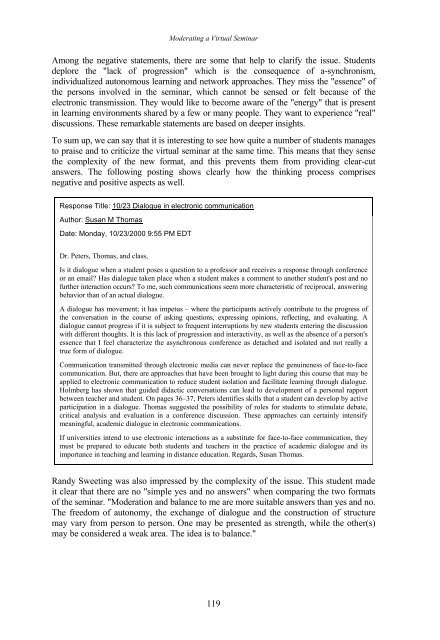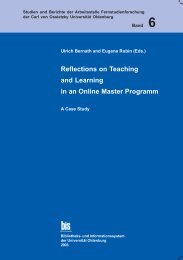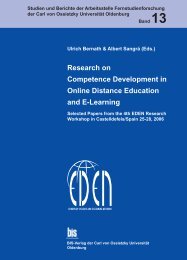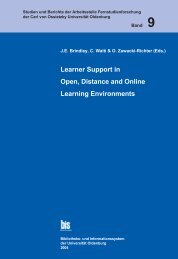Distance Education in Transition - Master of Distance Education ...
Distance Education in Transition - Master of Distance Education ...
Distance Education in Transition - Master of Distance Education ...
You also want an ePaper? Increase the reach of your titles
YUMPU automatically turns print PDFs into web optimized ePapers that Google loves.
Moderat<strong>in</strong>g a Virtual Sem<strong>in</strong>ar<br />
Among the negative statements, there are some that help to clarify the issue. Students<br />
deplore the "lack <strong>of</strong> progression" which is the consequence <strong>of</strong> a-synchronism,<br />
<strong>in</strong>dividualized autonomous learn<strong>in</strong>g and network approaches. They miss the "essence" <strong>of</strong><br />
the persons <strong>in</strong>volved <strong>in</strong> the sem<strong>in</strong>ar, which cannot be sensed or felt because <strong>of</strong> the<br />
electronic transmission. They would like to become aware <strong>of</strong> the "energy" that is present<br />
<strong>in</strong> learn<strong>in</strong>g environments shared by a few or many people. They want to experience "real"<br />
discussions. These remarkable statements are based on deeper <strong>in</strong>sights.<br />
To sum up, we can say that it is <strong>in</strong>terest<strong>in</strong>g to see how quite a number <strong>of</strong> students manages<br />
to praise and to criticize the virtual sem<strong>in</strong>ar at the same time. This means that they sense<br />
the complexity <strong>of</strong> the new format, and this prevents them from provid<strong>in</strong>g clear-cut<br />
answers. The follow<strong>in</strong>g post<strong>in</strong>g shows clearly how the th<strong>in</strong>k<strong>in</strong>g process comprises<br />
negative and positive aspects as well.<br />
Response Title: 10/23 Dialogue <strong>in</strong> electronic communication<br />
Author: Susan M Thomas<br />
Date: Monday, 10/23/2000 9:55 PM EDT<br />
Dr. Peters, Thomas, and class,<br />
Is it dialogue when a student poses a question to a pr<strong>of</strong>essor and receives a response through conference<br />
or an email? Has dialogue taken place when a student makes a comment to another student's post and no<br />
further <strong>in</strong>teraction occurs? To me, such communications seem more characteristic <strong>of</strong> reciprocal, answer<strong>in</strong>g<br />
behavior than <strong>of</strong> an actual dialogue.<br />
A dialogue has movement; it has impetus – where the participants actively contribute to the progress <strong>of</strong><br />
the conversation <strong>in</strong> the course <strong>of</strong> ask<strong>in</strong>g questions, express<strong>in</strong>g op<strong>in</strong>ions, reflect<strong>in</strong>g, and evaluat<strong>in</strong>g. A<br />
dialogue cannot progress if it is subject to frequent <strong>in</strong>terruptions by new students enter<strong>in</strong>g the discussion<br />
with different thoughts. It is this lack <strong>of</strong> progression and <strong>in</strong>teractivity, as well as the absence <strong>of</strong> a person's<br />
essence that I feel characterize the asynchronous conference as detached and isolated and not really a<br />
true form <strong>of</strong> dialogue.<br />
Communication transmitted through electronic media can never replace the genu<strong>in</strong>eness <strong>of</strong> face-to-face<br />
communication. But, there are approaches that have been brought to light dur<strong>in</strong>g this course that may be<br />
applied to electronic communication to reduce student isolation and facilitate learn<strong>in</strong>g through dialogue.<br />
Holmberg has shown that guided didactic conversations can lead to development <strong>of</strong> a personal rapport<br />
between teacher and student. On pages 36–37, Peters identifies skills that a student can develop by active<br />
participation <strong>in</strong> a dialogue. Thomas suggested the possibility <strong>of</strong> roles for students to stimulate debate,<br />
critical analysis and evaluation <strong>in</strong> a conference discussion. These approaches can certa<strong>in</strong>ly <strong>in</strong>tensify<br />
mean<strong>in</strong>gful, academic dialogue <strong>in</strong> electronic communications.<br />
If universities <strong>in</strong>tend to use electronic <strong>in</strong>teractions as a substitute for face-to-face communication, they<br />
must be prepared to educate both students and teachers <strong>in</strong> the practice <strong>of</strong> academic dialogue and its<br />
importance <strong>in</strong> teach<strong>in</strong>g and learn<strong>in</strong>g <strong>in</strong> distance education. Regards, Susan Thomas.<br />
Randy Sweet<strong>in</strong>g was also impressed by the complexity <strong>of</strong> the issue. This student made<br />
it clear that there are no "simple yes and no answers" when compar<strong>in</strong>g the two formats<br />
<strong>of</strong> the sem<strong>in</strong>ar. "Moderation and balance to me are more suitable answers than yes and no.<br />
The freedom <strong>of</strong> autonomy, the exchange <strong>of</strong> dialogue and the construction <strong>of</strong> structure<br />
may vary from person to person. One may be presented as strength, while the other(s)<br />
may be considered a weak area. The idea is to balance."<br />
119





